These beliefs and expectations operate to influence our behavior

האלגוריה של ההשגחה העליונה וכוחה (של משפחת) Trionfo della Divina Provvidenza,. 1632-39, ברבריני צייר ברטיני בקורטונה שפעל ברומא בשירותה של משפחת ברבריני והאפיפיור אורבנוס השמיני, בן המשפחה. בין היתר צייר את דיוקנאות בני המשפחה, עיצב ועיטר את ארמון ברבריני ברומא וצייר את הפרסקו הענק המעטר את תקרת ה"אולם קבלת הפנים" Salone dei Ricevimenti של הארמון. למעלה קטע קטן מהפרסקו, שציורו במשך שש שנים (1633-1639) "האלגוריה של ההשגחה העליונה וכוחה (של משפחת) ברבריני. מוצגים בארמון ברבריני שנמצא בדרום כיכר ברבריני. במרכז הכיכר ניצבת מזרקת טריטון מפורסמת. בארמון ברבריני נמצאת גם הגלריה הלאומית האיטלקית לאמנות עתיקה (Galleria Nazionale d'Arte Antica), שמכילה בתוכה את אחד מאוספי האומנות החשובים ביותר באיטליה. הארמון (Palazzo Barberini), נבנה בשנת 1549, על אדמה קדושה, עליה ניצב מקדש שאת שרידיו ניתן לראות בביקור בארמון, מכל מקום שמונים שנים לאחר מכן בן המשפחה, הכושל, הקרדינל אלסאנדרו ספורצה, נקלע לקשיים כלכליים. ומכר בשנת 1625 את המבנה למאפאו ברבריני, מי שהיה לאפיפיור אורבנוס השמיני. הציור של ברטיני בקורטונה מתחנף אליו ואל משפחתו. הארמן הפך להיות מרכז כוחה של משפחת ברבריני, משפחה שהגיע מפירנצה ולאט לאט הפכה להיות, אחת מהמשפחות החשובות של הפוליטיקה הרומאית. נחשב כמעט את המניפסט של הציור הבארוק, האלגוריה של ההשגחה העליונה וכוחה או ניצחון ההשגחה העליונה לפייטרו דה קורטונה הוא פרסקו מונומנטלי גדול המכסה את קמרון אולם הקבלה של ארמון ברבריני ברומא. במרכז התקרה, בתוך שטח המלבני, סצנה שמייצגת את ניצחון האפיפיורות והדת. צווי ההשגחה העליונה מסמלים את הסמל של משפחת ברבריני שאליה השתייך האפיפיור אורבן השמיני. ב-1637 ברטיני בקורטונה עבר לפירנצה, שם עיטר בפרסקאות, בשירותו של פרדיננדו השני דה מדיצ'י, בעקבות הצלחתו, הוא התבקש לעטר את חמשת החדרים בחזית הקומה המרכזית של הארמון (חדרי קבלת הפנים של הדוכס). דה קורטונה יצר חמישה חדרים הנקראים "חמשת כוכבי הלכת" אלא שבשנת 1647, עזב את פירנצה ותלמידו צ'ירו פרי השלים את החדרים. חדרים אלה היוו השראה לחדרי כוכבי הלכת בארמון ורסיי שהוזמנו על ידי לואי ה-14, מלך צרפת מאת שארל לה ברון.
The day will come when we will sit in front of the fireplace-
Hope and dopamine
From the responses to this article: Excellent read, I just passed this onto a colleague who was doing a little research on that. And he actually bought me lunch because I found it for him smile So let me rephrase that: Thank you for lunch!
In the 1950s researchers discovered in the brains of rats an area which they would be willing to die for the sake of it being stimulated. At first they thought this area of the brain is all about reward and pleasure. The dopamine hormone is produced its cells. This hormone is produced naturally in the brain and adrenal glands (in front of the 12 vertebrae of the thorax) and is the substance that creates our feelings of pleasure and it also reduces anxiety.
The rats were trained to press a lever for a particular prize, like sweet food or drink, or click on the pedal while running on a wheel in order to receive an electric stimulation to this part of the brain which produces dopamine.
To the surprise of researchers the rats would not stop running on this wheel, all in the hope of receiving this award. For it they were willing to neglect hygiene habits, off springs, and even nourishment.

The findings led the researchers to conclude that there is an area in the brain which is all about reward and pleasure. But over time it transpired that this area is not only in charge of producing the hormone responsible for pleasure, i.e. dopamine, a hormone which can also be produced by dancing, movement and sports or physical exertion as well as juice made from green leaves.

It turned out that when this area is activated repeatedly and powerfully a person develops a need to repeat the action which triggers it constantly. The biggest surprise was when it was revealed that the area in question does not deal with the actual receiving of the reward, but in the anticipation of the reward, the light at the end of the tunnel, in other words – hope.
This explains the idleness of many people, and backs up the “weakening phrases theory” which I have written about previously in my blog.
Addiction to ideas, anticipation and idleness
In the course of my work I have come across the continual expectation motif many a times. For example, people who feel good about themselves when they are busy and so constantly look for a subject of interest. They have emails, iPhones, laptops and smartphones as well as old encyclopaedias and all these in turn expose them to a flow of amazing ideas. These ideas spark their imagination and fill their lives with worth and meaning so much so that the persistent business of handling those objects ends up running their lives.

As soon as they come up with a new, exceptional idea their will go out to the market place and promote it with great anticipation. At first they will excite and inspire their friends with it, and they will they tell me of it in my clinic:
Producing water from air – like an air conditioner. Building a factory for teeth replacement which will take the size of said teeth with panoramic photography on the internet and will be marketed all over the world by having delivery stations in which they will be fitted by local doctors. Creating a chain of street food carts like the food cart in Thailand, turning the rubble of Gaza into electricity, using the rain floods in of the valleys of Jerusalem and turning them into a lake for growing edible fish and building in its surrounding area cafes and motels. The ideas they come up with in a week could potentially produce work for a whole country, if not an empire the size of the United States.
!The problem starts in the third session we have together – if not before , on the second
They are filled with confidence and joy: They have a new idea. A good, great idea, entirely different from the one they spoke of in the previous session. There is no talking to them at this stage about the reason for discarding the excellent idea from the previous meeting. The new idea is usually brilliant and compelling. The discourse in which they bring an infinite sequence of ideas is of no lesser brilliance than the idea itself which is all about firing up excitement in the listener, and indeed it succeeds in so doing. This sales talk creates an impression and persuades, fills one with hope and anticipation for a tremendous success and expectation for future profits on a grandiose scale.
They follow up with a third idea, and a forth and suddenly the disastrous truth reveals itself. They are addicted to ideas. They merely perfect their rhetoric, and do little work in order to realise these ideas if anything at all. The expectation of success and profit making is justified and is always there in the background.
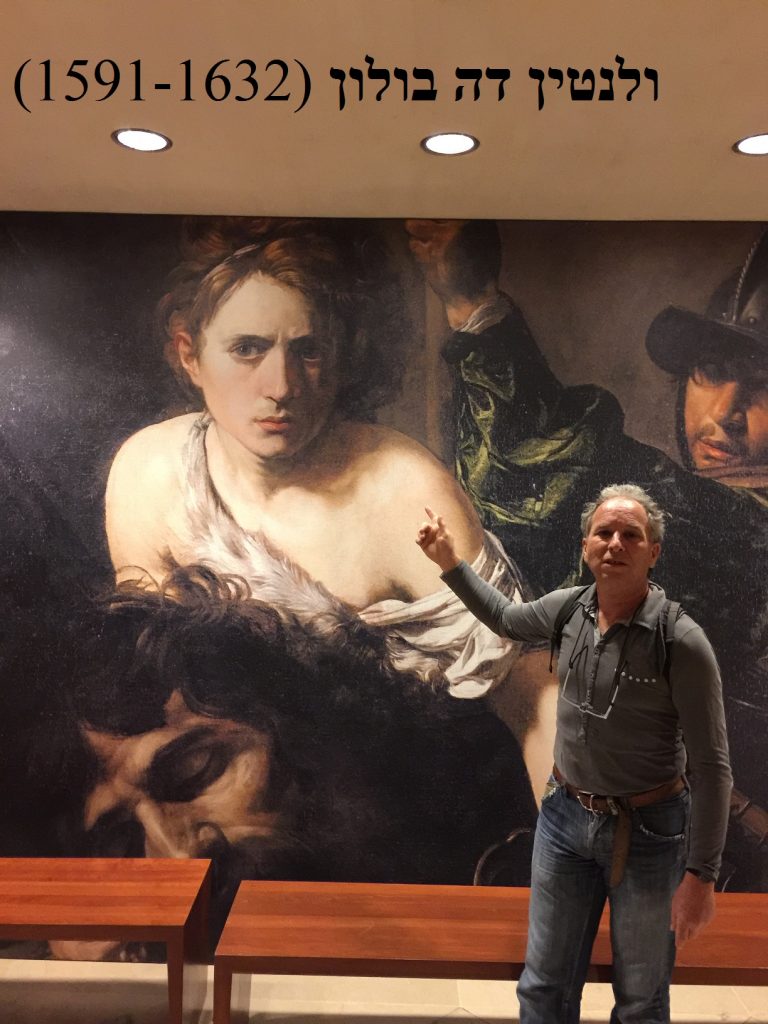
If one of these people would go for a career in sales they would receive a stable salary and many bonuses. But, the hope of gaining a fortune from the ever-flowing stream of ideas has a paralysing effect and does not allow these individuals to settle for less than the profit one would image gaining from manufacturing a rack sack containing a mechanism which would uplift a person and serve as a private car, able to transport one at the height of 5 feet above traffic level and has the potential to sell all over the world.
I call them myself the ideas-infatuated Don Juans, but what unites them in the end, except for being destitute and financial parasites on their families, is the sanctification of idleness and the addiction to hope and expectation.
Sadly they will not realise any of their ideas, as were they to do so the dopamine flow in their brains will stop.
This is a hope which hinders motivation, blocking the move towards an action that could potentially realise the wish. It fills our minds with dopamine as said earlier which is conceived as pleasure.
“Hope” is the name of Israel’s national anthem. Hope sells in our culture and is associated with the long wait of two thousand years for the return to Zion; if only we would believe in the coming of the messiah, in the divine assistance and God’s mercy – our lives would be painted pink and we would arrive safely and as if by miracle to the Promised Land. These are deep rooted expectations in the face of inaction.
The expectation is pleasurable. So much so that it is addictive and because of this pleasure of waiting for better things, it is that expecting the best to happen disrupts motivation and is often paralyzing. Being addicted to waiting threatens the waiting person with a deep and hard feeling of helplessness. However, hope is central to the teachings of Viktor Frankl. Viktor Emil Frankl was a neurologist and psychiatrist, a Viennese Jew, the founder of logotherapy. Frankl encourages hope as a force, strength and safety belt for desperate situations and for dealing with the cruelty one meets in life. According to him, what kept him alive in the concentration camp and helped him overcome typhus even, was hope. Hope which was embodied in a strong desire to restore and publish the manuscript of his book "The doctor and the soul: Introduction to Logotherapy" which was lost in Auschwitz. However, one has to distinguish the light at the end of the tunnel of brutality which one meets in different measure throughout daily life and only in extreme conditions, from the kind of waiting which castrates motivation.
In extreme situations when a person is faced with cruelty, hope enables one to survive in the face of evil. Its role is not to generate motivation for running a long and challenging career.
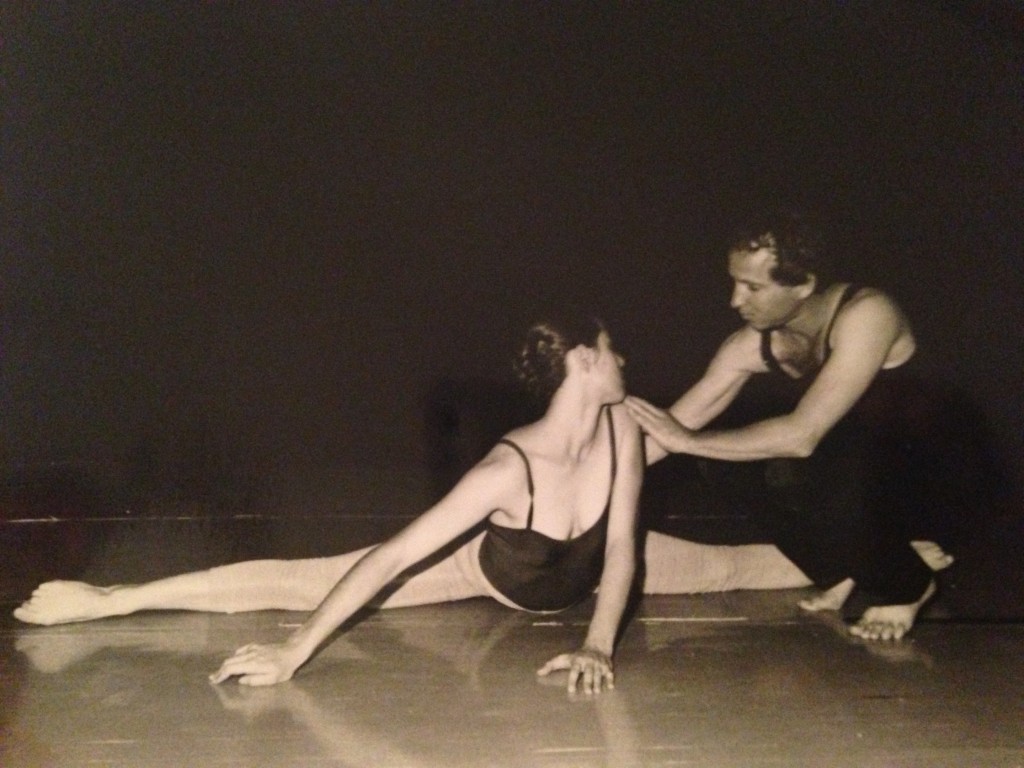
Through my work with dancers, athletes and people greatly motivated to build a career I noticed that the motivation of the person to reach significant achievements is depended on two factors which act in them simultaneously:
The first acts in their favour and is tied in their assessment of their chances to develop new life-skills as a result of the road they have embarked on, these new life-skills serving them on the road and allow them to reach success. They are curious as to the process in itself, and devote enormous effort to it.
The second which is tied in with motivation acts against them, and is all about hope and the addiction to hope.
The viewing is delightful – At the age of 61 and more than 15 years after retiring from the stage, Israeli dancer Yaron Margolin will again dance “Leontes”, one of the works he is identified with in Israel, and abroad. This amazing comeback will take place at the opening of the Dance Festival at Lincoln Center, New York, on January 9, 2015.
When I find out the importance of the success in my client’s eyes (whether he is in a state of chronic stagnation and helplessness, or is prosperous and successful) the exaggerated importance he/she gives to success is exposed. The exaggerated importance he/she assign to success on the one hand and on the other hand his/her negative perception of the skills he/she possesses in order to achieve it manages to castrate his/her motivation and extreme anticipation builds up.
The degree to which a person believes in his/her chances of success is strongly affected by self-esteem
The degree to which a person believes in his/her chances of success is strongly affected by self-esteem, his/her cooperation with me and from the things he/she was told about me before we started working together. If the person in question was told about the wonders I did for someone else – he/she finds it easier to cooperate.
A person who does not believe that he can succeed falls in to the trap of hope-dreams.
A person who does not believe that he can succeed falls in to the trap of hope-dreams.
He/she is saved by the help of tremendous anticipation and fantasy from the cruel perception (misperception in fact) of his abilities.
A person who becomes addicted to waiting and hoping will abstain right from the off from investing the necessary effort to achieve success out of a deep feeling of “I do not deserve success”, “There is no chance for me to develop new life skills”, “something is wrong with me! And other weakening phrases or a feeling of despair, stagnation, a sense that life is bad place full of cruelty, or false hope that something external will come to save him/her, and the result – when this condition is not treated – is the absence of motivation.
to learn more on weakening phrases you can read my article – here
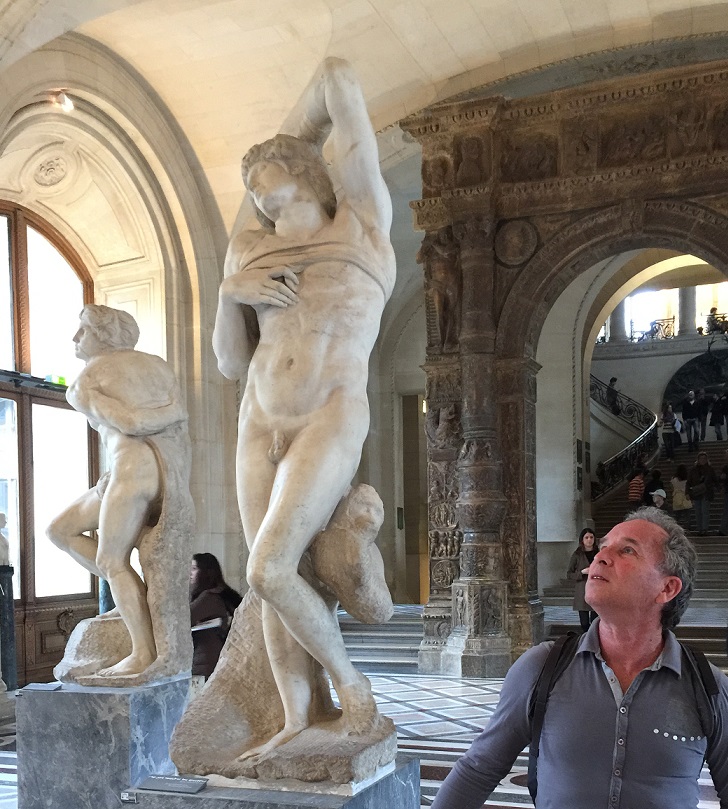
The danger lays in becoming addiction to expectation. A person addicted to hope and the dopamine that comes with it, delights in not having life skills, and the lack of meaningful action. He/she has no motivation. Even in cases where the person feels that he/she can execute the task, he/she will simply not bother to do so.
This full shut-down, which I as a therapist have to break through in order to help the waiting-person is linked with the very depth for his/her soul, which has built a construct of waiting-idleness and hoping for the best, on account of the absence of it in his/her life.
It is extremely difficult to dismantle the “good” legend which is absent from the life of a person addicted to expectation and dopamine.
In the five cases in which I had the occasion of taking such action I encountered tremendous and powerful difficulties, inflexibility, unrelenting stubbornness and blocks equal to tons of concrete, hindering the self from acting and realizing itself in the face of resistance and expectation.
Three common elements manifested themselves:
1. A very tight relationship, often symbiotic with a significant figure in childhood.
2. There were no apparent elements of true cruelty in the bodily shut-off points originating in childhood, or the experience of having to face traumatic life experiences such as abuse, exploitation, humiliation, or lack of respect.
3. The hope for better things was tied nevertheless with childhood. For example, Aviv Ben-Yehuda (a fictitious name) who grew up in a supportive and affluent home dreamed about having worn-out sports shoes like those of his three best friends whose parents could not afford expensive shoes.

נערים משחקים במדרחוב של טאורמינה
The shut-down (DMIMA – Hebrew) appears in the form of thought and the expectation for the better which created addiction to dopamine and also with an unsuitable the diet and in the skeletal muscle situated on the ulnar border of the palm of the hand (Musculus opponens digiti minimi manus).
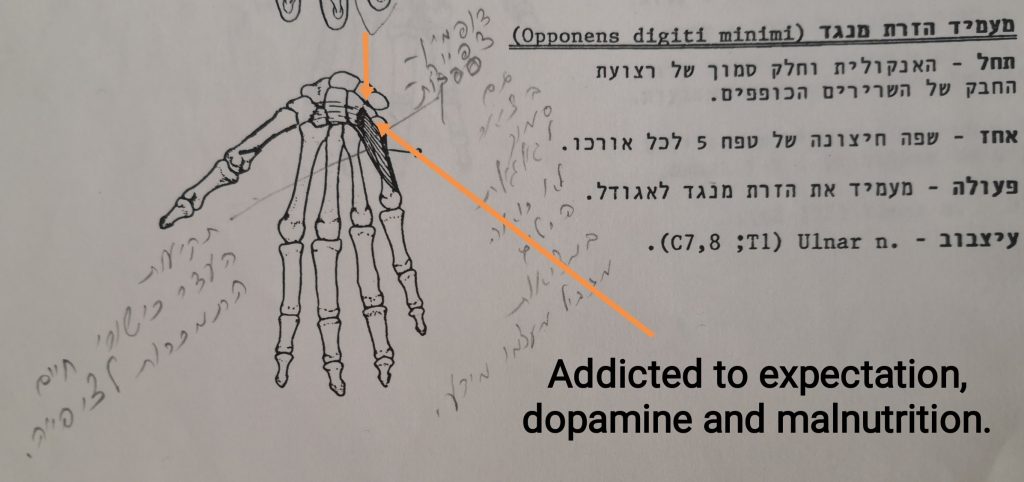
This muscle forms the ulnar border of the palm and its spindle-like shape defines the hypothenar eminence of the palm together with the skin, connective tissue, and fat surrounding it (the shut-down is also tied in with blindness at the face of important details of the reality around, and in addiction to exciting and great hopes).
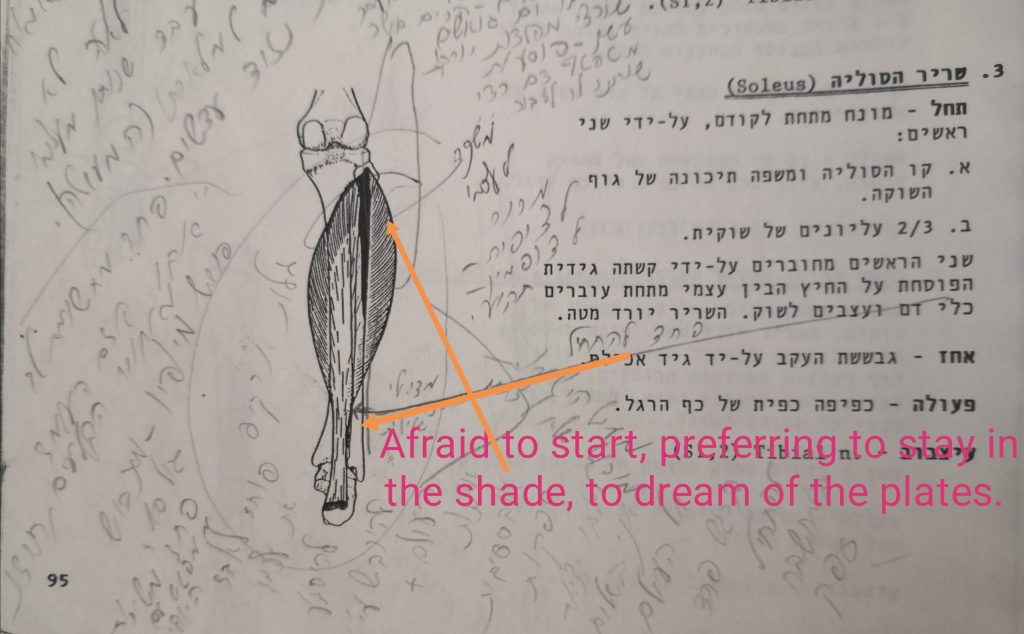
The Musculus soleus – a muscle situated behind the left calf is also tied in with the addiction to hope, expectation and its mythological character Echo – Narcissus’ girl. Eco prefers to look in admiration at Narcissus who is stuck in the pond whereas this Narcissus of hers is busy only with himself and with humiliating her. But Echo expects change and promises herself that Narcissus will eventually wake up and be grateful to her.
And so we become familiar with the shut-down in the left Achilles tendon, which is a part of part the twin muscle.
The vertebrae of the spine which are called the thoracic vertebrae T4, T2, and T5 (note the exclusion of T3) are also tied in with hoping for the best. And so the shut-down can also manifest itself in short muscles that rotate around that area of the body (Rotatores brevis) as a chronic muscular contraction or a vertebral fracture.
If you have any questions left –
I'd be happy to answer any questions.
For a direct application form to Yaron Margolin – please click here
לטופס פנייה ישירה אל ירון מרגולין – נא להקליק – כאן
Note: All of the above, is not a cure or a recommendation for treatment, it is merely food for thought.
Recent Articles
Kidney Failure Taming the Rogue Kidneys Vital Information
מאמרים אחרונים
מבוא לפסיכותרפיה מכלולית והוליסטית
הפסיכולוגיה הטיפולית וההוליסטית – תולדות הפסיכותרפיה
מגילת רות האלמנה שיצאה ממרחב הנוחות
יש פתרון כולל לבעיות הקשורות לדימוי עצמי, חוסר בטחון וערך עצמי נמוך – דופמין
איך מורידים לחץ וחרדות באופן טבעי? התמודדות עם סטרס ולחץ נפשי
טיפול נפשי ללא תרופות – חרדות, פחדים וייאוש – תסמינים שיש להם פתרון טבעי, מדויק ומהיר
חזרה לבסיס – עקרונות צירופי המזון
ראיית המעמקים – כניסה לטרקלין או על החיים האמתיים.
על היכולת להשתקם, לקום מאבק הדרך ומכאב הפרידה
מסלול ההתפתחות הנורמטיבי בחיי אדם ודמימותיו בטבלה – סדרת מאמרים.
לחלק השלישי – תפוח אדמה והבוטיראט
לחלק החמישי – נבטי הברוקולי וחלבון הנעורים
לחלק השישי – שיבולת השועל והבטא קלגן
עשרת המזונות הבריאים ביותר לחולי כלייה. 1
מדד חדש לבריאותך – ביטול האסרוסקלרוזים
אי ספיקת כליות – טיפול ללא תרופות
אוראה – למה האוראה מוגברת ומופחת בדם Urea
הקורטיזול וכאבים בבית החזה וביד שמאל
להוריד קריאטינין, אוריאה ולהחלים ללא תרופות מאי ספיקת כליות
-אי ספיקת כליות להחלים ללא תרופות – על הGFR ונזקי התרופות
ההומוציסטאין – האויב הגדול של האנדותל ובריאות העורקים
אי ספיקת כליות – אילוף הכליות הסוררות – כל מה שחשוב לדעת – חלק ג
אריתרופויטין (EPO) Erythropoietin
רוצה להחלים מפגיעה במערכת העיכול ללא תרופות?
להחלים בפשטות ממחלת ריאות חסימתית כרונית
שחיקת סחוס, למה לסבול? – ללא ניתוח ללא תרופות – טיפול להחלמה
עורקים גמישים – הסוד והדרך לזכייה בבריאות מחדש
ההומוציסטאין – האויב הגדול של האנדותל ובריאות העורקים
פרנצ'סקו מסינה Francesco Messina אלהים באדם שחיפש אחר היופי
התרופות והרע – ביוטין B7 ויטמין H
טיפול נפשי ללא תרופות – חרדות, פחדים וייאוש – תסמינים שיש להם פתרון טבעי, מדויק ומהיר
חזרה לבסיס – עקרונות צירופי המזון
ראיית המעמקים – כניסה לטרקלין או על החיים האמתיים.
מגיע לי – העדר הכרה במאמץ של השועט קדימה, בהחלט יכול להוביל לכישלונה של קריירה מזהירה.
סוכרת כלייתית (נפרופתיה סוכרתית) כן, אפשר להחלים".
כאבי גב – פתרון טבעי, עדין ופשוט לבעיה שלך
כאבי גב לא דורשים ניתוח – רק מגע יד עדינה
צום חי – הוא תרופה טבעית. אזהרה לקטונים (Lactones) –
אי ספיקת כליות מתוקה: (נפרופתיה סוכרתית) אפשר לצאת בשלום מהצרה המסוכנת לסוכרתיים – צום חי
אי ספיקת כליות – מתכונים לדיאטה מאוזנת – טעימה להשתגע.
אילוף הכליות הסוררות – איך להחלים מאי ספיקת כליות להקליק כאן
"אילוף הכליות הסוררות" תחילת פרק א
ההמשך לפרק א' של "אילוף הכליות הסוררות"- כאן.
נשארו לך שאלות
אשמח להשיב על כל שאלה
לטופס פנייה ישירה אל ירון מרגולין – נא להקליק – כאן
בבקשה לא להתקשר משום שזה פשוט לא מאפשר לי לעבוד – אנא השתמשו באמצעים שלפניכם –
למען הסר ספק, חובת התייעצות עם רופא (המכיר לפרטים את מצבו הבריאותי הכללי של כל מטופל או שלך) לפני שימוש בכל תכשיר, מאכל, תמצית או ביצוע כל תרגיל. ירון מרגולין הוא רקדן ומבית המחול שלו בירושלים פרצה התורה כאשר נחשפה שיטת המחול שלו כבעלת יכולת מדהימה, באמצע שנות ה – 80 לרפא סרטן. המידע באתר של ירון מרגולין או באתר "לחיצות ההחלמה" (בפיסבוק או MARGOLINMETHOD.COM ), במאמר הנ"ל ובמאמרים של ירון מרגולין הם חומר למחשבה – פילוסופיה לא המלצה ולא הנחייה לציבור להשתמש או לחדול מלהשתמש בתרופות – אין במידע באתר זה או בכל אחד מהמאמרים תחליף להיוועצות עם מומחה מוכר המכיר לפרטים את מצבו הבריאותי הכללי שלך ושל משפחתך. מומלץ תמיד להתייעץ עם רופא מוסמך או רוקח בכל הנוגע בכאב, הרגשה רעה או למטרות ואופן השימוש, במזונות, משחות, תמציות ואפילו בתרגילים, או בתכשירים אחרים שנזכרים כאן.

כתיבת תגובה